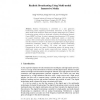Free Online Productivity Tools
i2Speak
i2Symbol
i2OCR
iTex2Img
iWeb2Print
iWeb2Shot
i2Type
iPdf2Split
iPdf2Merge
i2Bopomofo
i2Arabic
i2Style
i2Image
i2PDF
iLatex2Rtf
Sci2ools
PCM
2005
Springer
2005
Springer
Realistic Broadcasting Using Multi-modal Immersive Media
Realistic broadcasting is considered as a next generation broadcasting system supporting user-friendly interactions. In this paper, we define multi-modal immersive media and introduce technologies for a realistic broadcasting system, which are developed at Realistic Broadcasting Research Center (RBRC) in Korea. In order to generate three-dimensional (3-D) scenes, we acquire immersive media using a depth-based camera or multi-view cameras. After converting the immersive media into broadcasting contents, we send the immersive contents to the clients using high-speed and high-capacity transmission techniques. Finally, we can experience realistic broadcasting represented by the 3-D display, 3-D sound, and haptic interaction. Demonstrations show two types of broadcasting systems: the system using a depth-based camera and the system using multi-view cameras. From the realistic broadcasting system, we can generate new paradigms for the next generation digital broadcasting.
| Added | 28 Jun 2010 |
| Updated | 28 Jun 2010 |
| Type | Conference |
| Year | 2005 |
| Where | PCM |
| Authors | Sung-Yeol Kim, Seung-Uk Yoon, Yo-Sung Ho |
Comments (0)

